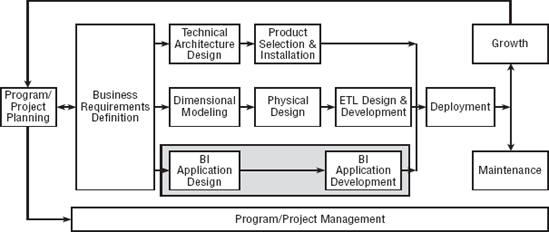Part 3. Developing the BI Applications
Chapter 10: Building BI Applications in Reporting Services
Chapter 11: PowerPivot and Excel
Chapter 12: The BI Portal and SharePoint
Chapter 13: Incorporating Data Mining
We've reached the point in the DW/BI Lifecycle where we can actually start delivering value to the business community. It turns out this delivery step is more important than you might think. We believe the business folks should be wildly enthusiastic about getting at their data and understanding it better.
The problem with this belief is that most business people do not seem to agree. In fact, based on our experience, you will be lucky to get 10 percent of your user base to actually build their own reports from scratch. We suspect this is because learning the tools and the data is just too far outside the comfort zone of most business people. Therefore, a critical part of every DW/BI project is providing the other 90 percent of the user community with a more structured, and easier, way to access the data warehouse.
This section is about the components in the SQL Server platform, and in the broader Microsoft product line, which you will use to close the last gap between the DW/BI system and the business users. These components include Reporting Services and Report Builder, Excel and PowerPivot, SharePoint, and SQL Server data mining.

The Kimball Lifecycle steps covered in Part 3
Get The Microsoft® Data Warehouse Toolkit: With SQL Server 2008 R2 and the Microsoft® Business Intelligence Toolset, Second Edition now with the O’Reilly learning platform.
O’Reilly members experience books, live events, courses curated by job role, and more from O’Reilly and nearly 200 top publishers.

